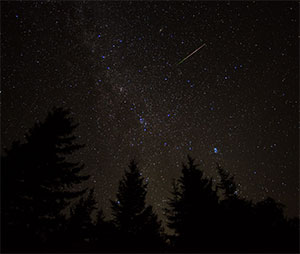UW Planetarium Programs Focus on Perseid Meteor Shower, Pluto During August
Published July 29, 2021

The Perseid meteor shower and Pluto are two celestial subjects that will highlight the schedule at the University of Wyoming Harry C. Vaughan Planetarium during August.
“During August, I look forward to celebrating the Perseid meteor shower and then marking another anniversary with the reclassification of Pluto,” says Max Gilbraith, the planetarium’s coordinator.
The Perseids are a prolific meteor shower associated with the comet Swift-Tuttle. The meteors are called the Perseids because the point from which they appear to hail lies in the constellation Perseus.
In August 2006, Pluto was reclassified from a planet to a dwarf planet. The reclassification was triggered by the discovery of many additional objects (the Edgeworth-Kuiper Belt) out beyond the orbit of Neptune. Some of the objects are nearly as big as and, in a few cases, possibly bigger than Pluto and in very similar orbits. As a result, it was realized that Pluto was just the largest of a large number of objects in the outer solar system.
A film and special live talk for audiences will be featured each week.
To get tickets or receive more information about programs, email planetarium@uwyo.edu or leave a voicemail and a call-back phone number at (307) 766-6506. Tickets are $5 for the public and $3 for students, senior citizens, veterans, first responders and those under 18. Seating is free for children under 5.
Reservations or pre-purchase is not required, and walk-ins are welcome. Tickets can be purchased online with a credit card, reserved by email or voicemail, or purchased at the start of the show. Cash or check is accepted at the door. The planetarium, which seats 58, is located in the basement of the Physical Sciences Building. Seating is on a first-come, first-served basis outside of designated ADA/wheelchair seating.
To pay for tickets with a credit card, go to https://www.uwyo.edu/uwplanetarium/ticket.aspx.
The August schedule is as follows:
-- “From Earth to the Universe,” Saturday, Aug. 7, 2 p.m. This 30-minute voyage takes the audience out to the colorful birthplaces and burial grounds of stars, and farther out beyond the Milky Way to the unimaginable immensity of myriad galaxies. The audience will learn about the history of astronomy, the invention of the telescope and today’s giant telescopes that allow researchers to probe deeper into the universe.
-- “Wyoming Skies -- Perseid Special,” Friday, Aug. 13, 7 p.m. This program provides an exploration of the stars, constellations, planets, meteor showers and other celestial phenomena visible from Wyoming for the season. There will be a focus on the Perseid meteor shower, which will peak Aug. 11-13, and its parent, Halley’s Comet.
-- “Hot and Energetic Universe,” Saturday, Aug. 14, 2 p.m. High-energy astrophysics plays a key role in understanding the universe. These radiations reveal the processes in the hot and violent universe. This science also probes hot gas in clusters of galaxies, as well as hot gas accreting around supermassive black holes in the centers of galaxies. High-energy radiation provides important information about our own galaxy, neutron stars, supernova remnants and stars, like our sun, which emit copious amounts of high-energy radiation.
-- “Exploration of Jupiter,” Friday, Aug. 20, 7 p.m. As the most massive object besides the sun in the solar system, Jupiter is a necessary drive-by for every mission to the outer solar system. Galileo first recorded the moons of this planet centuries ago. Scientists have since discovered that each moon is as varied and interesting as the planets from one another. Visitors will see the historic data from Jupiter, the latest from the Juno Mission and plans for future probes, such as the Europa Clipper.
-- Full-dome movie: “Mayan Archaeoastronomy: Observers of the Universe,” Saturday, Aug. 21, 2 p.m. This film tours six Mayan temples: San Gervasio, Chichen Itzá, Uxmal, Edzná, Palenque and Bonampak. Viewers will dive into a Mayan world of knowledge about the importance of the orientations of its temples in relation to the movement of some stars, such as the sun, the moon and Venus.
-- “Wyoming Skies,” Tuesday, Aug. 24, 7 p.m. This program provides an exploration of the stars, constellations, planets, meteor showers and other celestial phenomena visible from Wyoming for the season.
-- “Pluto and the Kuiper Belt,” Friday, Aug. 27, 7 p.m. Pluto was reclassified as a dwarf planet Aug. 24, 2006. Audience members can learn why Pluto was demoted and observe the data and discoveries of the New Horizons mission to the farthest reaches of our solar system.
-- Full-dome movie: “The Sun: Our Living Star,” Saturday, Aug. 28, 2 p.m. Viewers will discover the secrets of the sun and experience never-before-seen images of its violent surface in immersive full-dome format.
All programs are approximately an hour in length. As time allows, a portion of the show also may focus on a live sky tour or supporting information related to the film’s topic.
If you have a group larger than six, it is recommended to contact the planetarium for a private show at https://uwyo.sjc1.qualtrics.com/jfe/form/SV_bKuqIynOn7gFK2F, Gilbraith says. The rate for private shows is the same as ticket prices for public shows, he says.

